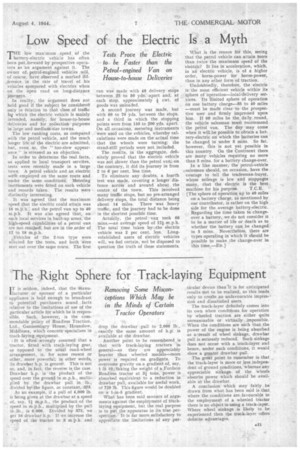The Right Sphere for Track-laying Equipment
Page 23

If you've noticed an error in this article please click here to report it so we can fix it.
Removing Some Misconceptions Which May be in the Minds of Certain Tractor Operators iT is seldom, indeed, that the -manufacturer or sponsor of a particular appliance is bold enough to broadcast to potential purchasers sound facts relative to the limitations of use of the particular article for which he is responsible. Such, however, is the commendable policy of Roadless Traction, Ltd., Gunnersbury House, Hounslow, Middlesex, which concern specializes in track-laying equipment.
It is often wrongly assumed that a tractor, fitted with track-laying gear, as Opposed to the usual road-wheel arrangement, is, for some reason or other, more powerful; in other words, . its drawbar h.p. is greater. This is not so, and, in fact, the reverse is the case. Drawbar h.p. is the product of the • speed over the ground in m.p.h., multiplied by the drawbar pull in lb., divided by the figure, or constant, 375.
As an example, if a pull of 4,000 lb. is being given at the drawbar at a speed of, say, 11 m.p.h., the product of the speed in m.p.h., multiplied by the pull in lb., is 6,000. Divided by 375, we get 16 drawbar h.p. If we increase the
speed of the tractor to 3 and drop the drawbar pull to 2,000 lb., exactly the same amount of h.p. is available at the drawbar.
Another point to be remembered is that with track-laying tractors in general—as they are appreciably heavier than wheeled models—more power is required on gradients. To overcome gravity on a gradient of, say, 1 in 10,,taking the weight of a Fordson Roadless tractor at 31 tons, power is absorbed equivalent to a reduction in drawbar pull, available for useful work, of 728 lb. This figure would be doubled on a 1-in-5 gradient.
What has been said savours of arguments against the employment of tracklaying equipment, but the real purpose is to put the apparatus in its true perspective. It is far more satisfactory to appreciate the limitations of any par
ticular device than It is for anticipated results not to be realized, as this tends only to create an unfavourable impres-thou and dissatisfied users.
The track-layer definitely comes into its own when conditions for operation by wheeled traction are either quite unreasonable or virtually impossible. When the conditions are such that the power of the engine is being absorbed as a result of wheel sinkage, drawbar pull is seriously reduced. Such sinkage does not occur with a track-layer and hence, under such conditions, it would. show a greater drawbar pull.
The great point to remember is that the track-layer is more or less independent of ground conditions, whereas any appreciable sinkage. of the wheels absorbs power which should be available at the drawbar.
A conclusion which may fairly be drawn from what has been said is that where the conditions are favourable to the employment of a wheeled tractor there is no object in using a track-layer. Where wheel sinkage is likely to be experienced then the track-layer offers definite advantages.




















































